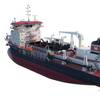New York to Conduct Explosives Detection Test
The SEACAP pilot employs passive millimeter wave technology to screen passengers for person-borne explosives before they board the ferry to lower Manhattan. Because the technology does not use whole body imaging, privacy issues will not be a concern. Testing will occur Monday through Friday during off-peak hours. Prior to boarding, passengers will move through the terminal's turnstiles at their normal pace. The screening equipment will be angled to passively screen passengers as they pass through turnstiles to enter the ferry terminal waiting area. Passengers will not be asked to stand in place, nor will they even need to break stride. Video images of the scanned passengers will be monitored by TSA's transportation security officers (TSOs) from a station set up to the side of the waiting area. The TSOs in the monitoring station will be in communication with roving TSOs and will notify them of any passengers who display an anomaly. An abbreviated pat down area will be available for resolution of those anomalies and TSA-certified explosive detection canine teams will be available to screen passengers' baggage.










